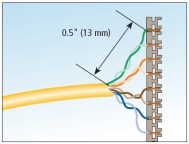Best practice in cable installation is a professional with the proper tools and certifications to ensure the proper installation of the network cabling. Many businesses aren’t willing to pay for this level of service. Often it falls on the IT department to install or supervise moves, adds, and changes to the network by unqualified personnel.
The trade-off in time and possible lost product is a business judgment exercised by management and is a reality of every network.
Still, quality testing and following a few simple rules will result in a network link or repair that can provide years of high-speed network performance.
- Know your job. Is this a repair of a failed network link or a whole new cable run? Where is the cable going? Is it just a short hop up and over the equipment rack to the next one? Or is it a couple hundred feet up a rise and across the plenum ceiling to a medical room? Careful here –there are no Etherpolice, but there is a fire marshal who doesn’t care anything about how much work it was to install a cable –it better have the right fire rating on the jacket. It is expensive and time consuming to remove thousands of feet of cable because a non-smoke-/flame-resistant cable was used.
- The cable must have the proper jacket material for the job. There are many types of jacket materials: Plenum, PVC, UV-resistant, mold-resistant, low temperature, to name a few. Use the proper jacket for the job at hand.
- The cable will have to be cut to length, the ends stripped off of the outer jacket material, and the connectors attached. The cable may very likely be pulled directly off the reel orspool into position through conduit, onto a cable tray or hung on J-hooks.
- All cable should be laid in as smoothly as possible, without damage to the jacket.
- When going around corners, a smooth radius should be maintained in accordance with the cable manufacturers’ specification. Remember that an Ethernet copper cable holds four twisted pairs of wire. A kink or sharp bend will affect the relationship of the twisted pairs, allowing electrical noise or crosstalk into the communication signals. Continue reading
Filed under: IT Infrastructure | Tagged: cable installation, copper best practices, copper cable, copper cable installtion | Leave a comment »







